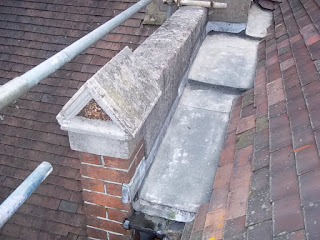In the last couple of years I've more or less become my own builder and whilst renovating my house have come across a lot of lead in one form or another. To the best of my knowledge, lead is only used for roofs and flashing in modern structures.
 |
| Lead roofing |
At the time our house was built, all the plumbing was lead tubing, working with this stuff would have been hard, a 10 metre run of pipe would have been heavy and it probably needed two men to install, one to do the bending and another to support the pipe until it could be secured to the structure. Relative to modern plastic plumbing, forming joints and connections would have been a lengthy and skilled task in which the pipe and solder(?) had similar melting temperatures.
 |
| A tee junction in lead piping |
 |
| Lead Sheathed Cable |
Apart from drafts rattles, sash windows are an attractive feature of Victorian houses, concealed in the frames are four counterweights, in the case of our house, there is more than quarter of a ton of cast iron in the windows, however, in grander properties with large windows, lead was used for the sash weights.
Lead would also have been present in accumulators which were used for door bells and other signalling devices and later to heat the filaments in valve radios. Local shops offered to charge up the accumulators, maybe for a shilling, which was a very expensive way of buying electricity.
Various lead based materials were in regular use, the most common was paint. Lead paints had a reputation for durability and the pretense of lead implied a premium product. Whilst lead is no longer used in paint, its previous large scale use makes it necessary to take precautions when sanding down old doors and window frames to avoid inhaling the dust. Another one was "red lead" which was a sealing compound used with iron and brass pipe fittings.
Until relatively recently tetra-ethyl lead was used in petrol to prevent "pre-ignition" and was often referred to as an "anti-knocking" additive. The engines in early cars were large had low compression ratios, for example the Model T ford had a swept volume of 2900 cc and a compression ratio of around 4. When lead as added to petrol, compression ratio could be increased to around 7 or 8 which increased the efficiency of the engine allowing the size of engine to be reduced for a given output. At the end of the 1930s small cars typically had 1,000 cc engines. At one time petrol was sold according to with its octane rating denoted by a number of stars and the higher the octane rating, the higher the price and lead content. By the 1970s, the used of lead in petrol was seen to be detrimental to public health and its used was phased out.



No comments:
Post a Comment